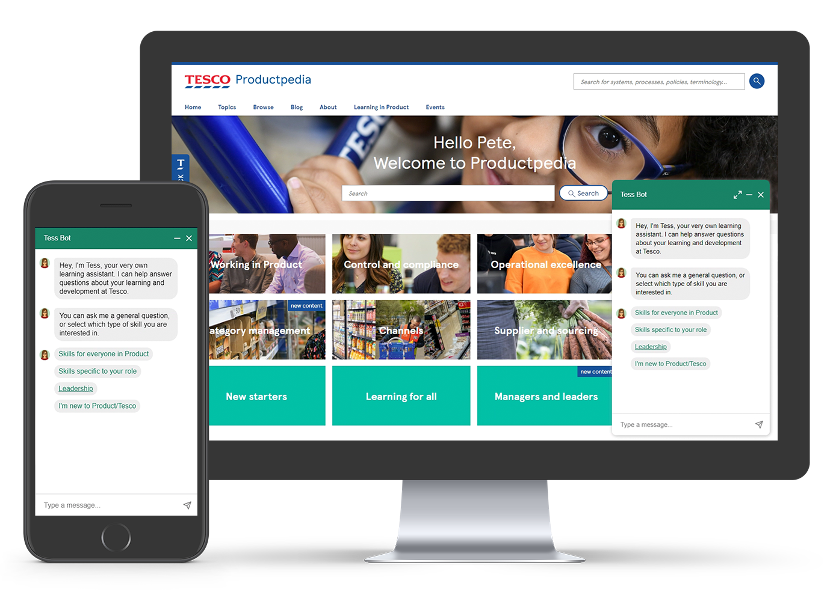- Call: 0203 427 3507
- Email: innovation@clustre.net

Well-implemented Conversational AI solutions have the potential to reinvent the relationship between an organisation and its employees. By streamlining and personalising processes, digital/virtual assistants or chatbots can:
As the workforce continues to evolve, with employees becoming more distributed and accustomed to remote working and mobile communication, organisations can embrace chatbot technology to streamline and improve accessibility to HR information and processes.
In certain areas and deployed in the correct manner, Conversational AI automation can help to significantly boost efficiency in how organisations train, manage and work with their employees.
So how should an organisation start to implement this technology effectively, and once deployed, how can it be harnessed to drive continuous improvement and bring further benefits?
To help answer these questions, we arranged for Liisa Brade, Capability Manager for digital learning at Tesco PLC, to share her experiences as the guest speaker at our senior executive Breakfast Briefing at the Delaunay, in London, on 20th April.
Liisa has worked at Tesco for over 20 years, during which she’s held a number of roles in Learning and Development, with a particular focus on digital transformation. Liisa leads the digital transformation for Tesco’s online Product learning platform with a clear roadmap of improvements ahead whilst working with team and subject matter experts to keep the platform current and relevant for all colleagues in the Product division.
The Product Learning and Development team at Tesco supports thousands of colleagues each day, providing training materials and guidance on a wide range of topics. Due to legacy systems, colleagues were struggling to easily find the right learning content, and the L&D team, with stretched resources, was unable to provide 1:1 coaching for all. Tesco were looking for a low cost, high value solution to better cater to their colleagues’ needs.
Partnering with Filament, Liisa and her team designed and developed Tess, a 24-7 chatbot, allowing colleagues to ask questions and receive answers about learning and development, policies and systems at any time. Tess is now trained to handle hundreds of queries (with more being added each week) as well as allowing employees to follow more complex conversational flows to help them find the right information they need. Topics covered include:
Tess is integrated on every page of the ‘Productpedia’ site, Tesco’s Product Learning & Development portal, built on SharePoint / Microsoft 365, so users can easily access her wherever they are browsing.

Tess is created and managed by Liisa and her team with the help of EBM, the Enterprise Bot Manager from Filament. EBM is a no-code/low-code platform that can provide teams with the tools and operating model required to deliver effective digital assistant programs quickly and effectively and to manage and monitor them for continued success.
Liisa’s team at Tesco were provided with training on how to use EBM, allowing them to monitor all interactions with Tess, through to editing and adding new content daily. This ensures that Tess is trained to provide increasingly helpful and targeted responses as more people interact with her over time.
Live for over two years now, Tess has supported thousands of colleagues with a wide variety of queries in a timely, intuitive and efficient manner.
It’s usually easy to prove the quantitative value of chatbots that have been deployed for customer support, particularly when it comes to demonstrating return on investment. It’s often trickier to garner the same quantitative value of a chatbot when it comes to improving the employee experience and colleague efficiency. To help evaluate the benefits Tess provides to colleagues, Liisa’s team have included timely feedback surveys as part of Tess’s content, ensuring that users are able to provide quick, helpful feedback on their interactions with the chatbot.
The surveys have proved that Tess has been a welcome tool for colleagues in the Tesco product team, whether they’re new to the organisation or have been in the team for many years. Overall, Tess has received an average satisfaction score of 4 out 5.
Naturally, one of the first questions for Liisa was around the time and effort it took to get Tess up and running for users to start making use of the chatbot.
Once the necessary IT and compliance hurdles had been passed, Liisa, her team and Filament were able to start work and deploy Tess to users within a couple of months, following these primary key project steps:
Like all digital projects, the time and effort required to implement a successful chatbot project is dictated by key factors such as the requirements of the use case, the complexity of the integrations, the availability of existing content and the required testing time. However, there are some key considerations that can help to build efficiencies in your chatbot project:
Digital assistants and chatbots have become a vital tool for businesses looking for innovative ways to increase efficiency and, in most cases, save resources. However, it was highlighted in the session that the success or failure of any digital assistant is not just down to the technology that powers them, but also to the employees entrusted to manage them.
When embarking on a chatbot or digital assistant it’s vital to consider who will be responsible for maintaining it and ask if they have the right skills for the job.
Liisa and her team exemplify the skills and traits required for good chatbot management:
With such a diverse set of skills required, it’s not surprising that all the responsibilities are sometimes shared between multiple team members. Indeed, larger bots will have dedicated teams of people working on them.
As with most things in life, the more you put in, the more you will get out and this is true in the world of chatbots and digital assistants. Investing in specialist chatbot managers will ensure your Conversational AI solution is set up for long-term prosperity.
Liisa explained that part of the reason Tesco is able to explore and implement new technologies to help improve the experience of colleagues is the culture of innovation that Tesco has put in place.
During the discussion it was highlighted that many organisations will often prioritise ‘moon-shot’ innovation: large initiatives intended to make a large and immediate impact on customers. This can often mean that shorter-term objectives and efforts at continuous innovation are deprioritised or not put in place.
Through the availability of key resources and investment, Tesco have established a proud track record of innovation, and dedicated teams ensure they continue to focus in this area. For example, this is the mission statement of Tesco Labs, the research and development team within Tesco Technology:
We work across the Innovation Horizons, from nearer term opportunities to testing hypotheses in experimental, breakthrough innovation. Our aim is to create a culture of innovation by inspiring our colleagues and the wider community.
Now that Liisa and her team have been able to successfully establish a chatbot platform that provides benefits to Tesco’s colleagues, proving the value of Conversational AI, Tesco are proactively exploring ways in which they can expand Tess’s capabilities:
In the spirit of continuous innovation, Tesco are also beginning to explore other use cases for Conversational AI, for example: